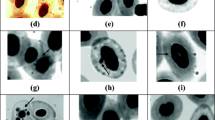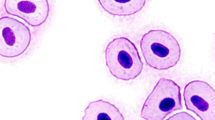Abstract
Pollutants and toxic contaminants produced in all parts of the world are transported to remote regions including Antarctica. Tourism, research, and fishing activities on this continent are another source of contamination. Toxic substances affect Antarctic species, and some produced genomic damage to the fauna. The genetic damage can be detected by microscopic observation of erythrocytic nuclear abnormalities (ENAs). We counted the number of ENAs in seven populations of three Pygoscelid penguin species, Adélie (Pygoscelis adeliae), Chinstrap (Pygoscelis antarctica), and Gentoo (Pygoscelis papua), and found important differences among species exposed to the same conditions. ENAs were more frequent in Adélie penguins than in the other two species. Inter-population comparisons within species showed remarkable differences in Adélie and Chinstrap penguins but not in Gentoo penguin. Frequency of ENAs in Adélie penguins was the highest in Yalour Island population, intermediate in King George Island population, and the lowest in Torgersen Island and Avian Island populations. In Chinstrap penguins, the highest number of ENAs was found on Deception Island, and significant differences were found only between Deception Island and King George Island populations. This information will provide baseline data to be used for assessing the evolution of genomic damage of penguins along the Antarctic Peninsula in the future.




Similar content being viewed by others
References
Afanasieva K, Rushkovsky S, Bezrukov V (2006) Parameters of chromosomal instability of Pygoscelis papua. Bulg Antarct Res Life Sci 5:9–13
Agresti A (2002) Categorical data analysis, 2nd edn. Wiley, New Jersey
Artaxo P, Rabello MLC, Maenhaut W, Vangrieken R (1992) Trace elements and individual particle analysis of atmospheric aerosols from the Antarctic Peninsula. Tellus B 44:318–334
Barbosa A, Merino S, Benzal J, Martínez J, García-Fraile S (2007a) Population variability in heat shock proteins among three Antarctic penguin species. Polar Biol 30:1239–1244
Barbosa A, Merino S, Benzal J, Martínez J, García-Fraile S (2007b) Geographic variation in the immunoglobulin levels in pygoscelid penguins. Polar Biol 30:219–225
Barbosa A, Demas E, Benzal J, Diaz JI, Motas M, Jerez S, Pertierra L, Benayas J, Justel A, Lauzurica P, García-Peña FJ, Serrano T (2013) Pollution and physiological variability in gentoo penguins at two rookeries with different levels of human visitation. Antarct Sci 25:329–338
Bargagli R (2005) Antarctic ecosystems: environmental contamination, climate change, and human impact. Springer, Berlin
Boersma PD (2008) Penguins as marine sentinels. Bioscience 58:597–607
Cavas T, Ergene-Gozukara S (2005) Micronucleus test in fish cells: a bioassay for in situ monitoring of genotoxic pollution in the marine environment. Environ Mol Mutagen 46:64–70
Cipro CVZ, Taniguchi S, Montone RC (2010) Occurrence of organochlorine compounds in Euphausia superba and unhatched eggs of Pygoscelis genus penguins from Admiralty Bay (King George Island, Antarctica) and estimation of biomagnification factors. Chemosphere 78:767–771
Corsolini S, Covaci A, Ademollo N, Focardi S, Schepens P (2006) Occurrence of organochlorine pesticides (OCPs) and their enantiomeric signatures, and concentrations of polybrominated diphenyl ethers (PBDEs) in the Adélie penguin food web, Antarctica. Environ Pollut 140:371–382
Corsolini S, Borghesi N, Schiamone A, Focardi S (2007) Polybrominated diphenyl ethers, polychlorinated dibenzo-dioxins, -furans, and -biphenyls in three species of Antarctic penguins. Environ Sci Pollut R 14:421–429
Crawley MJ (2007) The R book. Wiley, New York
Crockett AB, White GJ (2003) Mapping sediment contamination and toxicity in Winter Quarters Bay, McMurdo Station, Antarctica. Environ Monit Assess 85:257–275
Deheyn P, Gendreau RJ, Baldwin MI, Latz MI (2005) Evidence for enhanced bioavailability of trace elements in the marine ecosystem of Deception Island, a volcano in Antarctica. Mar Environ Res 60:1–33
Dertinger SD, Torous DK, Tometsko KR (1996) Simple and reliable enumeration of micronucleated reticulocytes with a single-laser flow cytometer. Mutat Res-Genet Toxicol 371:283–292
Dommergue A, Sprovieri F, Pirrone N, Ebinghaus R, Brooks S, Courteaud J, Ferrari CP (2010) Overview of mercury measurements in the Antarctic troposphere. Atmos Chem Phys 10:3309–3319
Eppley ZA (1992) Assessing indirect effects of oil in the presence of natural variation—the problem of reproductive failure in south polar skuas during the Bahia Paraiso oil-spill. Mar Pollut Bull 25:307–312
Eppley ZA, Rubega MA (1989) Indirect effects of an oil-spill. Nature 340:513
Ergene S, Çavaş T, Çelik A, Köleli N, Kaya F, Karahan A (2007) Monitoring of nuclear abnormalities in peripheral erythrocytes of three fish species from the Goksu Delta (Turkey): genotoxic damage in relation to water pollution. Ecotoxicology 16:385–391
Fenech M (2000) The in vitro micronucleus technique. Mutat Res 455:81–95
Geisz HN, Dickhut RM, Cochran MA, Fraser WR, Ducklow HW (2008) Melting glaciers: a probable source of DDT to the Antarctic marine ecosystem. Environ Sci Technol 42:3958–3962
Guerra BMB, Schaefer CEGR, Rosa PDF, Simas FNB, Pereira TTC, Pereira-Filho ER (2011) Heavy metals contamination in century-old manmade technosols of Hope Bay, Antarctic Peninsula. Water Air Soil Poll 222:91–102
Guilherme S, Valega M, Pereira ME, Santos MA, Pacheco M (2008) Erythrocytic nuclear abnormalities in wild and caged fish (Liza aurata) along an environmental mercury contamination gradient. Ecotoxicol Environ Saf 70:411–421
Hardy ICW, Field SA (1998) Logistic analysis of animal contests. Anim Behav 56:787–792
Jerez S (2012) Los pingüinos: bioindicadores de la contaminación ambiental en la península Antártica e islas asociadas. PhD Dissertation. University of Murcia
Jerez S, Motas M, Palacios MJ, Valera F, Cuervo JJ, Barbosa A (2011) Concentration of trace elements in feathers of three Antarctic penguins: geographical and interspecific differences. Environ Pollut 159:2412–2419
Jerez S, Motas M, Benzal J, Diaz J, Vidal V, D’Amico V, Barbosa A (2013a) Distribution of metals and trace elements in adult and juvenile penguins from the Antarctic peninsula area. Environ Sci Pollut Res 20:3300–3311
Jerez S, Motas M, Benzal J, Diaz J, Barbosa A (2013b) Monitoring trace elements in Antarctic penguin chicks from South Shetlands Islands, Antarctica. Mar Pollut Bull 69:67–75
Kennicutt MCII, Sweet ST (1992) Hydrocarbon contamination on the Antarctic Peninsula: III. The Bahía Paraiso—two years after the spill. Mar Pollut Bull 25:303–306
Kennicutt MC, Mcdonald GJ, Denoux SJ (1992a) Hydrocarbon contamination on the Antarctic Peninsula. 1. Arthur Harbor—subtidal sediments. Mar Pollut Bull 24:499–506
Kennicutt MC, Mcdonald GJ, Denoux SJ (1992b) Hydrocarbon contamination on the Antarctic Peninsula. 2. Arthur Harbor interdial and subtidal limpets (Nacella-Concinna). Mar Pollut Bull 24:506–511
Kleinjans JCS, Van Schooten FJ (2002) Ecogenotoxicology: the evolving field. Environ Toxicol Pharmacol 11:173–179
Krahn MM, Pitman RL, Burrows DG, Herman DP, Pearce RW (2008) Use of chemical tracers to assess diet and persistent organic pollutants in Antarctic Type C killer whales. Mar Mamm Sci 24:643–663
Kursa M, Bezrukov V (2007) Health status in an Antarctic top predator: micronuclei frequency and white blood cell differentials in the south polar skua (Catharacta maccormicki). Polarforschung 77:1–5
Lenihan HS (1992) Benthic marine pollution around McMurdo station, Antarctica: a summary of findings. Mar Pollut Bull 25:318–323
Marko PB, Nance HA, Van der Hurk P (2014) Seafood substitutions obscure patterns of mercury contamination in Patagonian toothfish (Dissostichus eleginoides) or “Chilean sea bass”. Plos One. doi:10.1371/journal.pone.0104140
Marques SM, Antunes SC, Pissarra H, Pereira ML, Gonçalves F, Pereira R (2009) Histopathological changes and erythrocytic nuclear abnormalities in Iberian green frogs (Rana perezi Seoane) from a uranium mine pond. Aquat Toxicol 91:187–195
Matsumoto ST, Mantovani MS, Malaguttii MIA, Dias AU, Fonseca IC, Marin-Morales MA (2006) Genotoxicity and mutagenicity of water contaminated with tannery effluents, as evaluated by the micronucleus test and comet assay using the fish Oreochromis niloticus and chromosome aberrations in onion root-tips. Genet Mol Biol 29:148–158
Muller WU, Nusse M, Miller BM, Slavotinek A, Viaggi S, Streffer C (1996) Micronuclei: a biological indicator of radiation damage. Mutat Res-Rev Genet Toxicol 366:163–169
Quirós L, Ruiz X, Sanpera C, Jover L, Piña B (2008) Analysis of micronucleated erythrocytes in heron nestlings from reference and impacted sites in the Ebro basin (N.E. Spain). Environ Pollut 155:81–87
R Development Core Team (2010) R: A language and environment for statistical computin. R Foundation for statistical computing, Vienna
Schiavone A, Corsolini S, Kannan K, Tao L, Trivelpiece W, Torres D, Focardi S (2009) Perfluorinated contaminants in fur seal pups and penguin eggs from South Shetland, Antarctica. Sci Total Environ 407:3899–3904
Schmid W (1975) Micronucleus test. Mutat Res 31:9–15
Tao L, Kannan K, Kajiwara N, Costa MM, Fillmann G, Takahashi S, Tanabe S (2006) Perfluorooctanesulfonate and related fluorochemicals in albatrosses, elephant seals, penguins, and polar skuas from the Southern Ocean. Environ Sci Technol 40:7642–7648
Tin T, Fleming ZL, Hughes KA, Ainley DG, Convey P, Moreno CA, Pfeiffer S, Scott J, Snape I (2009) Impacts of local human activities on the Antarctic environment. Antarct Sci 21:3–33
Van Den Brink NW (1997) Directed transport of volatile organochlorine pollutants to polar regions: the effect on the contamination pattern of Antarctic seabirds. Sci Total Environ 198:43–50
Van Ngan P, Gomes V, Passos M, Ussami KA, Campos DYF, Rocha AJD (2007) Biomonitoring of the genotoxic potential (micronucleus and erythrocyte nuclear abnormalities assay) of the Admiralty Bay water surrounding the Brazilian Antarctic Research Station “Comandante Ferraz,” King George Island. Polar Biol 30:209–217
Walker CH (1990) Persistent pollutants in fish-eating sea birds—bioaccumulation, metabolism and effects. Aquat Toxicol 17:293–324
Wania F, Mackay D (1993) Global fractionation and cold condensation of low volatility organochlorine compounds in Polar regions. Ambio 22:10–18
Yogui GT, Sericano J (2008) Polybrominated diphenyl ether flame retardants in lichens and mosses from King George Island, maritime Antarctica. Chemosphere 73:1589–1593
Acknowledgments
M.J.P. was supported by a Ph.D. grant from the Spanish Ministry of Science and Education (BES2005-8465). We thank the Spanish Antarctic base “Gabriel de Castilla,” the Argentinean Antarctic base “Carlini” (ex Jubany), the UTM (Maritime Technology Unit, CSIC), the Spanish Polar ship Las Palmas and the Argentinean Antarctic Institute for their logistic support. Permission to work in the study area and for penguin handling was granted by the Spanish Polar Committee. This is a contribution to the International Polar Year project 172 BIRDHEALTH and to PINGUCLIM project. Deborah Fuldauer revised the language of the manuscript. We greatly appreciate for the comments of three anonymous reviewers which improved an early version of the manuscript. This study was funded by the Spanish Ministry of Science and Innovation and the European Regional Development Fund under the Projects REN2001-5004/ANT, CGL2004-03148, POL2006-05175, CGL2007-60369 and CTM2011-24427 during writing.
Conflict of interest
The authors declare that there are not conflicts of interest.
Author information
Authors and Affiliations
Corresponding author
Rights and permissions
About this article
Cite this article
De Mas, E., Benzal, J., Merino, S. et al. Erythrocytic abnormalities in three Antarctic penguin species along the Antarctic Peninsula: biomonitoring of genomic damage. Polar Biol 38, 1067–1074 (2015). https://doi.org/10.1007/s00300-015-1667-2
Received:
Revised:
Accepted:
Published:
Issue Date:
DOI: https://doi.org/10.1007/s00300-015-1667-2




